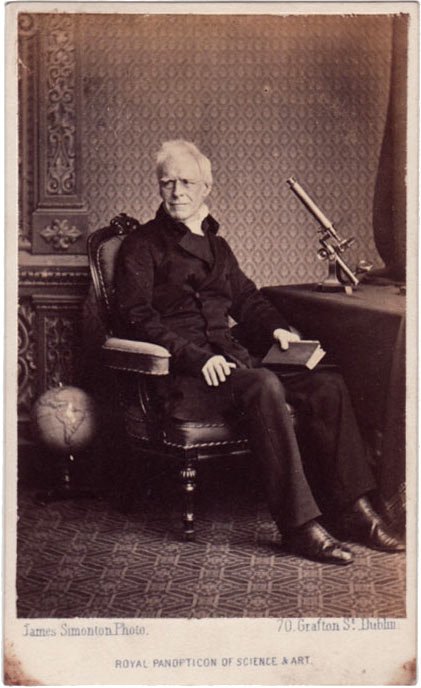Thomas Romney Robinson (1792-1882) was an Irish astronomer and physicist who made significant contributions to astronomy, meteorology, electricity, magnetism, turbines, air-pumps, fog signals, and balloons[6]. He was born in Dublin on April 23, 1792, and was a child prodigy, reading avidly by the time he was three, and having a book of his poetry published when he was only 13[6]. Robinson became Rector of Enniskillen and then Director of Armagh Observatory when he was 31[6].
Education and Career
Robinson’s technical and scientific interest developed rapidly as a schoolboy, and he took his BA at sixteen years old and became a fellow of Trinity College, Dublin at 21[3]. He was named after his father’s painting master, George Romney, and the family moved to Ireland, living first in Dublin, before moving to the north of Ireland, where they lived near Dromore under the patronage of Bishop Thomas Percy[2]. They then moved to Lisburn and later Belfast, where Thomas attended the Belfast Academy and took a great interest in physics and shipbuilding[3].
Robinson was the long-time director of the Armagh Astronomical Observatory, one of the chief astronomical observatories in the UK of its time[1]. With the help of Archbishop Beresford and his own innate enthusiasm for science, he obtained a number of new instruments and performed numerous observations[4]. He contributed several thousand pounds of his own money to refurbish the Observatory with the best instruments available[3].

Contributions to Science
Robinson is remembered as the inventor of the 4-cup anemometer[1]. He also contributed many papers on astronomy and a range of topics in physics to the journals of several societies, of some of which he was an active member[2]. Robinson made significant contributions to astronomy, including the construction of a 6-foot diameter speculum mirror for the Armagh Observatory’s reflecting telescope[3].
Robinson’s most significant contribution to astronomy was his work on star positions. He spent 25 years making rigorous and tedious observations, many of them made by Robinson himself, and published the Armagh Catalogue of Stars in 1859[2]. This enormous body of work was the result of twenty-five years of rigorous and tedious observations, many of them made by Robinson himself, and it is largely for this catalogue that he was awarded the Royal Medal of the Royal Society in 1862[2].
Robinson was also involved in the construction of Lord Rosse’s giant telescope, one of Ireland’s greatest contributions to science, and for 60 years the largest in the world[5].
Legacy
Robinson died suddenly on February 28, 1882, at his home near the observatory[4]. His collection of rare and antiquarian books and all his papers are in the archives of Armagh observatory library[4]. Robinson’s legacy is significant, and he is remembered as a remarkable man of many interests who made significant contributions to science, particularly in the field of astronomy[3].
Citations:
[1] https://en.wikipedia.org/wiki/Thomas_Romney_Robinson
[2] https://www.dib.ie/biography/robinson-thomas-romney-a7735
[3] https://www.armagh.space/heritage/armagh-observatory/history/thomas-romney-robinson-and-the-new-instruments
[4] https://www.armagh.space/notable_figure/thomas-romney-robinson
[5] https://adsabs.harvard.edu/full/1971IrAJ…10…93C
[6] https://www.inventricity.com/local-heroes-thomas-romney-rob
The best way to keep in touch and to be aware of our events
Don’t forget to confirm your subscription in the Email we just sent you!

Please pre-book your visit over Christmas at least 24h in advance via Email or Online booking.
MondayClosed
Tuesday10:00 AM - 5:00 PM
Wednesday10:00 AM - 5:00 PM
Thursday10:00 AM - 5:00 PM
Friday10:00 AM - 5:00 PM
Saturday11:00 AM - 5:00 PM
Sunday11:00 AM - 5:00 PM
Adult €7.50
Children 10 to 16 €3
2 Adults & 2 Children €15
Adult is 16 years+
Family Ticket is 4 family members together
Children under ten are free but must be accompanied by an Adult

The Maria Edgeworth Centre is operated under the direction of the Edgeworthstown District Development Association (EDDA) – a Not for Profit Voluntary Community based registered charity Reg:223373. Registered Charity Number 20101916
© 2023 Maria Edgeworth Centre – All Rights Reserved
On the 17th of August 2024 as part of Heritage Week, with support from the County Heritage Officers, the Heritage Council, Longford County Council Libraries, Archives, Arts and Heritage,
IMMA, OPW and the Computer and Communications Museum Ireland on the NUIG Campus,
Ray Jordan and volunteers from the Maria Edgeworth Centre aim to simulate Edgeworth’s 1803 transmission by telegraph.
Click the link below to learn more or to register to attend either in person or via Zoom.
Join us for this recreation of a key moment in the history of communications